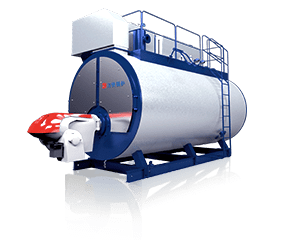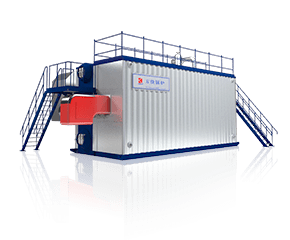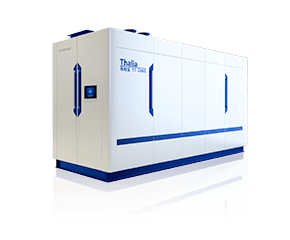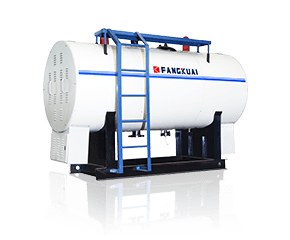As an endorsement of green environmental protection, natural gas has been widely promoted and popularized in my country. However, the high gas price has also made many enterprises and units using
gas-fired boilers very worried, which means that a large amount of fuel costs are spent every year to support the normal operation of the boiler. How to save the operating cost of the boiler is one of the key concerns of enterprises. In addition to paying attention to the use of natural gas boilers, the thermal efficiency of the boiler itself is also an important criterion for whether the boiler can save energy. Today, Henan Fangkuai Boiler discusses these issues about the energy saving technologies of gas boilers.
1. Reduce exhaust heat loss
The exhaust heat loss is mainly affected by the exhaust temperature and the excess air coefficient α. If the excess air coefficient α is too large, the amount of flue gas will increase and more heat will be taken away, so it should be as much as possible on the premise of ensuring the combustion efficiency of the boiler. In order to reduce the excess air coefficient, the burner can be configured reasonably and the strict operation and debugging can be used to match the structural characteristics of the boiler body and the type and characteristics of the fuel to ensure that the flame is full in the furnace and the fuel is fully burned.
Select a burner with proportional adjustment function, which can automatically adjust the supply of gas and the ratio of air with the change of heating load, so that the gas boiler can always maintain a high combustion efficiency within the load change range, while ensuring reasonable The excess air system reduces the heat loss of the exhaust gas and improves the thermal efficiency of the boiler.
Since the heat loss carried by the water vapor accounts for 55% to 75% of the heat loss of the exhaust gas, if the exhaust gas temperature is lowered below the dew point of the flue gas, the latent heat of the water vapor can be effectively reduced by recycling the latent heat of the exhaust gas. Exhaust heat loss, improve boiler thermal efficiency. For this reason, it is necessary to adopt a low-temperature heat absorption device and achieve a condensation effect for heat recovery. The low temperature endothermic device can be divided into two types: integral type and separated type. The integral type is the so-called condensing boiler, and the separate type is to install a waste heat recovery device in the flue outside the conventional boiler.
2. Condensation waste heat recovery technology
A condensing boiler refers to a boiler that can absorb the latent heat of vaporization contained in water vapor from the flue gas discharged from the boiler. Conventional boilers transfer most of the sensible heat in the flue gas to water or steam, while condensing boilers not only transfer a larger part of the sensible heat to water or steam, but also absorb part of the latent heat of vaporization released by the condensation of water vapor in the flue gas.
Condensing boilers are very different from traditional boilers in design ideas. Condensing boilers must have condensing heat exchange heating surfaces and use high-performance shell insulation and sealing materials. Use low-temperature water to reduce the exhaust gas temperature of the boiler to below the condensation temperature of the flue gas, so that the superheated water vapor in the flue gas condenses into water, and releases the latent heat of vaporization, and this part of the heat is recovered and used in the boiler. Calculated based on the low calorific value of fuel, the overall efficiency can be 10% to 17% higher than that of traditional shell boilers. The exhaust gas temperature can be reduced to 50℃~70℃. The condensing boiler not only saves energy, but also can remove harmful substances in the flue gas while condensing the water vapor in the flue gas, and can recover a considerable amount of water, which has the characteristics of
energy saving, water saving and environmental protection. Condensing boilers have been widely used abroad.
3. Conventional boilers are equipped with waste heat recovery devices
Separate flue gas waste heat recovery devices can generally be divided into direct contact heat exchangers and indirect heat exchangers.
The direct contact heat exchanger uses water spray to directly contact the flue gas for heat and mass exchange. This method has a high heat recovery rate and absorbs a large amount of harmful substances in the flue gas. However, the water quality recovered by this method is acidic, and its use is limited. The hot water generated by waste heat recovery is difficult to use in general civil heating boiler rooms, so heating Boiler rooms generally do not use this method.
Indirect heat exchanger is also called flue gas condensation heat energy recovery device. Due to the high water vapor content in the flue gas of the gas boiler, the water vapor in the flue gas releases a large amount of latent heat of vaporization during the condensation process, which makes the condensing waste heat recovery device used in the gas boiler more effective than the economizer used in the traditional
coal-fired boiler. The efficiency is high. The addition of a flue gas waste heat recovery heat exchanger on the conventional boiler flue can improve the thermal efficiency of the boiler, reduce the waste of energy, and reduce the operating cost of the user.





